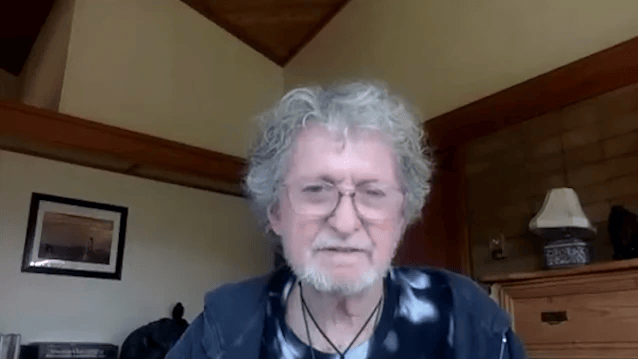
After Legend Jon Anderson revealed that he had begun writing his autobiography, two of his followers decided to……..
When Jon Anderson appears on TV, he exudes a Yogi-like calmness. “I’ve written down all the things I have to think about every day,” he says with a high, unmistakable rasp. “Humility, good listening skills, respect, flexibility, and positivism…”
The surrounding visual confusion is distracting: a home studio space happily filled with various musical gadgets, including a harp and what appears to be a hammered dulcimer. “I’ve had a studio for probably 20 years or so, and it got rather messy,” he recalls with a laugh. “I had a couple of folks come up and renovate my studio, but it’s still a mess.”
The physical space reflects the singer’s brain: expansive, vibrant, and always humming. The same might be said about “Close to the Edge,” which is the most elaborate and cinematically orchestrated rock tune ever recorded.
By 1972, Yes had established themselves as one of prog’s best bands, riding high on the success of their fourth album, the previous year’s Fragile, which peaked at No. 4 in the United States and produced a bonafide radio hit, the joyful and relatively bite-sized “Roundabout.” But the band—Anderson, guitarist Steve Howe, bassist Chris Squire, keyboardist Rick Wakeman, and drummer Bill Bruford—was plainly itching to go somewhere even bigger than earlier mini-epics like “Heart of the Sunrise” and “South Side of the Sky.”
During the marathon Fragile tour, Anderson absorbed a variety of mind-expanding influences, including the spiritual journey of Hermann Hesse’s 1922 novel Siddhartha, Wendy Carlos’ ambient synth album Sonic Seasonings, and Jean Sibelius’ one-movement Symphony No. 7. It all came together into a free-flowing 19-minute marathon of folk, jazz-fusion, church music, classical, heavy rock, and sound effects that makes up the first half of their critically acclaimed fifth album.
Over a half-century later, you couldn’t blame Anderson for being a little fuzzy on the specifics. (Or, for that matter, a little distracted: at the time of our conversation, he was preparing for a tour of Yes’ “epics” and “classics” with the Band Geeks, whose new album, TRUE, is due out Aug. 23. That’s not to mention his continuing effort, “Opus Opus,” which he’s steadily complete. A friend of mine, who is an excellent orchestra player, added some orchestra to it. All I need now is a twenty-person choir. [Laughs.] “That is all I need.”
Instead, his memory is present as we go along one of the most twisting corridors in progressive music history.
Inspirations
We were on the Fragile Tour. And on tour, you have plenty of time to think about things during the day while traveling. I had a suitcase that opened to reveal a boombox inside. I had my own studio, complete with cassettes and other equipment. I noticed I was listening to Sibelius’ Symphony No. 7 twice or three times per day, and then with headphones. I was absolutely intrigued by the notion that it was like living in a state of emptiness—you never knew what would happen next. [Rock] songs are usually six or seven minutes long, or less, and you recognize them when you hear them on the radio. But when you have a piece of music that is always evolving, it still surprises you every time you listen to it.
I discussed it with Steve, and he started putting down some suggestions. I remember we were at a Holiday Inn somewhere, and I was walking to breakfast when I passed Steve’s room. The smoke was coming from beneath the door—an early joint or whatever. He’s playing this guitar idea, and on the way back, I stopped to ask, “What are you doing?” He said, “I’ve got this stuff. It says “Close to the edge / round by the corner.” I asked, “Is that it?” I said, “Continue with the chords. “Down at the end/Round beside a river.” I’d just finished reading the great book Siddhartha, about a guy named Siddhartha who traveled the world in search of a connection with God. He eventually discovered it within himself along a river. I began singing ideas to him, and by the conclusion of the journey, we had some preliminary drawings of concepts.
Band Chemistry
The best thing about working with Steve was that we were incredibly compatible. He’s a fantastic guitarist, and I could strum three chords by then—that was my contribution. I recall getting into the concept of organization, and Chris and Bill would do things while Steve and I did things. We also had Rick, of course. I heard them playing a riff [vocalizes]. I kept hearing it over there by the side of the studio, and I remember saying, “We’re going to go from this to that. How do we do this? I do not know!” [Engineer/co-producer] Eddie Offord was present, which was fantastic. It was one of those eras when everyone was extremely open to abstract musical reality. We messed about with stuff on Fragile, but I believe by the time we got to Close to the Edge, we had memorized a lot of music—and then moved on to the next piece, and so on.
I recall that we were recording the music that preceded the middle portion, which became the dreamlike section. The fascinating part is that they would focus on everything being so tight. I enjoyed listening to them and was always thinking about the next section. Walter Carlos, whom I eventually met as Wendy, had Sonic Seasonings: this strange nothingness music, and I really liked the notion. I believe Bill and I came up with some ideas, and Eddie Offord returned with a tape of sound effects and such. So we ended up with a strange, picturesque sound board. Bill was clanging empty milk bottles.
The Full Sonic Spectrum
There’s a kitchen sink in there! [Laughs.] We used to ask, “Is the kitchen sink in there yet?” It’s fascinating to perform the song with School of Rock [the student musicians with whom Anderson previously toured]. This music was created 50 years ago, and these very young musicians are enjoying it. I charge in: “A seasoned witch might call you from the depths of your shame/And reorganize your liver to the firm mental grace.”
What words! “Rearrange your liver” means rearranging your bodily self into a more peaceful cause for living. What if you only live because you have to? No. Everybody has the same potential. The question is just how you get there. We’re all looking, and I believe that’s where [Indian-American monk/yogi Paramahansa] Yogananda enters the verse.
There were two or three motions before we got there, but I knew I was being guided by everyone. I did not say, “Now we are going to do this.” I’d ask, “What were you doing before?” “Can we do anything with that?” That’s something to build on. After a half-hour/45 minutes, you record it. For me, the pinnacle of the piece’s progression occurs precisely in the center. Steve added some chords, and I recall writing, “Two million people, scarcely content / Two hundred ladies watch one woman cry / Too late.”
I believe it was a time when people sought to save the globe from starvation. This energy was out there; why not sing about it? How many millions do we deceive with our honest eyes?
After we finished recording the song in the middle, I remarked, “We’re going to do another “I get up, I go down.” I’ll go up for a higher note, and then we’ll crash into the side of the studio like a huge roar, followed by Rick Wakeman’s solo! Later, Steve revealed, “I actually wrote a song with these chords.” He sang, “In her white lace, / You could clearly see the lady looking sorrowful.” I said, “Let’s go record it!” I’m confident it will work for me because I’m not singing on your front bar. Everything worked out perfectly.
He just went in and sang it, and Eddie simply pressed the trigger, and I began singing my part. It was like, “Thank you, whoever’s in charge!” [Looks up at the heavens].

The Genius of Eddie Offord
[The piece’s success] was largely due to Eddie Offord’s remarkable ability to capture the sound of everything. We eventually came to the point—I believe after a month—where we had to edit it together. We’d put it together as an idea, then another idea. When you get to the sixth concept, you wonder, “Where did it start?” But gradually, there was a method to the chaos of how it was built.
You would use a 24-track tape, which is about three inches wide, to record. And then you get the mix to sound great, and you transfer it to a quarter-inch tape, so you have your mixes on a quarter-inch tape. Nothing to do with computers! But, of course, Eddie would number the portions and attach them to the wall. You’d move to the opposite end of the studio, where there were probably two dozen lines of tape with numbers on it. I would remark, “Eddie, I hope you understand what you’re doing.” He’d say, “I’ve got it figured out.” “Here, take a joint.” [Laughs.]
By the time we came to the end of mixing, I believe we were emotionally and physically exhausted, but eager to see how it worked. We’d edit bits together, and then you’d be able to sit back and listen for 10 or 12 minutes. “Wow, we’re barely halfway done. “So much to do!” We can’t simply end with “I get up, I get down!” Many of the lyrics were written spontaneously. I’m already discussing the scene: “The time between the notes connects the color to the scenes.”
The Cleaning Lady’s Episode
[We were nearing the conclusion] of editing “Close to the Edge,” and I remember looking up and seeing all these streams of quarter-inch tape hanging down from the wall, complete with numbers. Eddie was quite on top of everything. About an hour before, this lady who lived next door to the studio came in to clean up every Friday. I believe her name was Lizzy. She’d walk in and say, “Hi, you people. Move around—I need to get my brush underneath your seats here. “I’ve got job to do.” It was like Monty Python. Edie replied, “OK, I need the next [one].” It is not here. It was immediately before “Seasons will pass you by / I get up”—it goes to the high note, but it doesn’t appear. We all looked at the floor and exclaimed, “Lizzy was just here cleaning up.”
Eddie said, “Oh fuck.” He dashed for the door, and we all ran outside, where it was raining. He’s in the bins, pulling out all the tapes. He found it: “Here it is! “32—got it!” He brings it back inside the studio and cleans it thoroughly. We were so exhausted. Mixing can take all day for just 10 minutes of music. We put it together and prayed, and it worked. Then we were able to listen to the entire piece of music. That was confusing.
You forget what goes where. Before you realize it, you have the feeling: “This is a monster. This has really taken on a life of its own.” I just remember him being such an excellent producer—as the person with the tape. He simply knew where he was heading.
How It Changed Him
It was a dream come true for me—and, I believe, for many others who believed that music did not have to be broadcast on the radio. [Laughs.] It is music that survives. When I’m on tour with the teenagers, I just say, “We’re going to do a song now that was made 50 years ago,” and it’s still fresh and alive for some reason, although some music on the radio 50 years ago may have been forgotten. You’ve got to know about a Beatles song.
You must be familiar with the golden age of R&B in the 1960s. “Close to the Edge,” for some reason, has [kept] the concept of Yes and music as more than just a radio tune.






